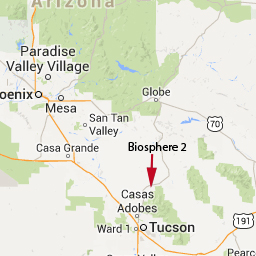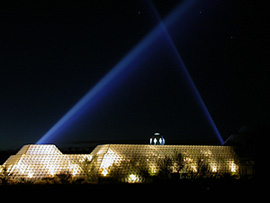Thoughts
about a unique facility:
Biosphere-2, Arizona


"The Human Experiment"
Near Oracle, Arizona, USA, Sept.
26, 1993: The first crew of biospherians reenter Earth's atmosphere after
living inside the Biosphere-2 facility for
two years

Biosphere-2 was the world's largest closed
ecological life support system. Nestled among the cacti and sagebrush at the foot of
Catalina Mountains, Biosphere-2 sits there like a giant spaceship, elegantly glittering,
breathtaking from sunrise to sunset -- a beautiful place, stimulating thoughts
and contemplation.
In September
1991, eight ecological pioneers
started a 2-year's stay inside the Biosphere-2 complex, a $200 million
structure covering more than three acres (>10.000 square meters),
sealed by a stainless-steel latticework containing more than 6.500 panes
of glass -- a life machine designed for a 100-year operation.
 One
of the many engineering problems was to keep the entire structure essentially airtight, in spite of large daily and
seasonal temperature variations. The solution was found by building two
huge rubber-and-aluminum 'lungs' connected to the main structure by air
tunnels. Operating in the 'closed' mode, these expand and contract as
air
heats and cools from day to night, thus reducing pressure differences
between
inside and outside to fractions of a percent. (The Lung concept was invented by Bill
Dempster, chief engineer for the Biosphere-2 project of Space
Biospheres Ventures. I'll never forget the tour he gave me and my family through the 'bowels' of this enormous machine.)
One
of the many engineering problems was to keep the entire structure essentially airtight, in spite of large daily and
seasonal temperature variations. The solution was found by building two
huge rubber-and-aluminum 'lungs' connected to the main structure by air
tunnels. Operating in the 'closed' mode, these expand and contract as
air
heats and cools from day to night, thus reducing pressure differences
between
inside and outside to fractions of a percent. (The Lung concept was invented by Bill
Dempster, chief engineer for the Biosphere-2 project of Space
Biospheres Ventures. I'll never forget the tour he gave me and my family through the 'bowels' of this enormous machine.)
Large-scale life
support systems are a big issue in spaceflight physiology. Dr. Heinz
Oser, then European Space Agency
Life Sciences Coordinator, helped me to
find access to the staff creating Biosphere-2. My primary contact person
was Mark Nelson, at that time Space Biospheres Ventures director of Space
Applications. I was invited to visit the plant, and to give a Guest
Lecture,
which I did in July 1991 -- a few months before the Austrian
cosmonaut Franz Viehböck was catapulted into orbit from the Baykonur launchpad
in Kazakhstan. Back then, the steel-and-glass dome was still
unfinished, and after donning a hard hat, I was given a tour of the
site.
With that, I realized just how big and unique -- and potentially useful
as a physiological research tool -- this structure really is.
Biosphere 2 became, and still remains, an unparalleled equipment.
A privatly run enterprise -- managed by dedicated idealists
(if not to say visionaries) who started relatively unimpeded by overwhelming
scientific scrutiny -- sufficed to put together this unparalleled laboratory in a matter
of only a few years. Probably no university would have done this; no government agency would have done
this either. A unique mix of people, ideas, and private money could.
 From
the beginning, the
project was much disputed. The scientific community was largely
sceptical, citing numerous concerns, such as the the fact that the
people who managed Biosphere-2 were 'no real
scientists'. So what? The Karl-Franzens-Universityin
Graz is named after the Habsburg archduke Karl II who founded
the
University in 1585, and after Emperor Franz I who reestablished it in
1827.
Neither Karl nor Franz were scientists. Does this mean no
decent
science is being conducted at the University? Certainly
not: The principal
project investigator -- not the owner or manager of a research facility
-- is responsible for study design, data collection and interpretation,
and publication of the results.
From
the beginning, the
project was much disputed. The scientific community was largely
sceptical, citing numerous concerns, such as the the fact that the
people who managed Biosphere-2 were 'no real
scientists'. So what? The Karl-Franzens-Universityin
Graz is named after the Habsburg archduke Karl II who founded
the
University in 1585, and after Emperor Franz I who reestablished it in
1827.
Neither Karl nor Franz were scientists. Does this mean no
decent
science is being conducted at the University? Certainly
not: The principal
project investigator -- not the owner or manager of a research facility
-- is responsible for study design, data collection and interpretation,
and publication of the results.
However:
After
sky-high
enthusiasm at the beginning, the news media soon got sceptical. Time
Magazine listed in its June 14, 1999, issue 'The
100 Worst Ideas of the Century' -- Biosphere 2
amongst them. The reason? Problems during the course of
the experiment -- e.g., 7 tons of oxygen disappeared from the
atmosphere into the fresh concrete
structure, unexpectedly, and oxygen had to be pumped into the system
from the outside; the biospherians had not enough food to keep their
body weight; the balance of species turned out to be problematic; etc.
But this
is exactly why experiments are conducted: To learn from problems an new
challenges. We want to experience something new, things do not need to
behave as
expected. To cite William C. Harris, Biosphere 2's former executive
director: 'The
nature of science is, anytime you do any kind of research, lessons are
learned. One of the things they learned during the original experiment
was that it's pretty hard to play God and run all the things on the
planet ....'
Biosphere-2 is a place where
many aspects of integrative physiological research aspects could be
tested
in ways nowhere else possible. It was designed as a long-term enterprise. The
issue of sustaining life in remote, large materially closed
environments -- such as on other planets -- is not yet finished; we clearly need much more research into this important area.
Helmut G. Hinghofer-Szalkay
'Biosphere
2 will continue to stimulate the minds of those who have vision to think
beyond the veil of tradition'
(Marino BDV,
Odum HT. Biosphere 2: Introduction and research progress. Ecol Engin 1999;
13: 3-14)
![]()

![]()
![]()

![]()
 One
of the many engineering problems was to keep the entire structure essentially airtight, in spite of large daily and
seasonal temperature variations. The solution was found by building two
huge rubber-and-aluminum 'lungs' connected to the main structure by air
tunnels. Operating in the 'closed' mode, these expand and contract as
air
heats and cools from day to night, thus reducing pressure differences
between
inside and outside to fractions of a percent. (The Lung concept was invented by Bill
Dempster, chief engineer for the Biosphere-2 project of Space
Biospheres Ventures. I'll never forget the tour he gave me and my family through the 'bowels' of this enormous machine.)
One
of the many engineering problems was to keep the entire structure essentially airtight, in spite of large daily and
seasonal temperature variations. The solution was found by building two
huge rubber-and-aluminum 'lungs' connected to the main structure by air
tunnels. Operating in the 'closed' mode, these expand and contract as
air
heats and cools from day to night, thus reducing pressure differences
between
inside and outside to fractions of a percent. (The Lung concept was invented by Bill
Dempster, chief engineer for the Biosphere-2 project of Space
Biospheres Ventures. I'll never forget the tour he gave me and my family through the 'bowels' of this enormous machine.)
 From
the beginning, the
project was much disputed. The scientific community was largely
sceptical, citing numerous concerns, such as the the fact that the
people who managed Biosphere-2 were 'no real
scientists'. So what? The Karl-Franzens-Universityin
Graz is named after the Habsburg archduke Karl II who founded
the
University in 1585, and after Emperor Franz I who reestablished it in
1827.
Neither Karl nor Franz were scientists. Does this mean no
decent
science is being conducted at the University? Certainly
not: The principal
project investigator -- not the owner or manager of a research facility
-- is responsible for study design, data collection and interpretation,
and publication of the results.
From
the beginning, the
project was much disputed. The scientific community was largely
sceptical, citing numerous concerns, such as the the fact that the
people who managed Biosphere-2 were 'no real
scientists'. So what? The Karl-Franzens-Universityin
Graz is named after the Habsburg archduke Karl II who founded
the
University in 1585, and after Emperor Franz I who reestablished it in
1827.
Neither Karl nor Franz were scientists. Does this mean no
decent
science is being conducted at the University? Certainly
not: The principal
project investigator -- not the owner or manager of a research facility
-- is responsible for study design, data collection and interpretation,
and publication of the results.